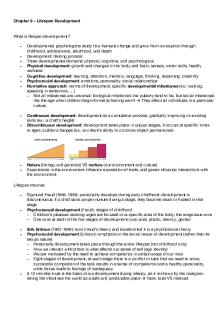Lifespan Development Powerpoint CLC PDF

| Title | Lifespan Development Powerpoint CLC |
|---|---|
| Author | Josue De Aquino |
| Course | General Psychology |
| Institution | Grand Canyon University |
| Pages | 12 |
| File Size | 1.4 MB |
| File Type | |
| Total Downloads | 76 |
| Total Views | 179 |
Summary
PowerPoint presentation about the development of lifespan....
Description
Prenatal development, infancy and childhood, adolescences and emerging adulthood, early, middle, and late adulthood. Cheyenne Niles Nathaniel Gray Nanea Wong Yuen Josue Deaquino Thamara Lamour
Overview
https://www.verywellmind.com/child-development-theories2795068#piagets-cognitive-developmental-theory
•
Physical development
•
Cognitive development
•
Socioemotional development
•
What factors impact development
Thamara Lamour
Cognitive Development • Theory of mind • Schemas • Assimilation • Accommodation
Physical development • Maturation • Innate survival skills
Cheyenne Niles
physical, cognitive, and socioemotional development in this infancy
• Through early connections and with sustaining, responsive communications, babies and little children learn methods of finding relationships, how to get their necessities and needs met, and how to distinguish and direct feelings. Since these abilities foster together, this space of improvement is alluded to social-emotional development.
Nanea Wong Yuen
AMBIVALENT REACTION
• Inconsolable • Resentful • Unsecure Attachment
SECURE REACTION • Distressed • Comforted • Secure Attachment
Factors ◦ Infancy ◦ Relationships with adults ◦ Attachments ◦ Interactions
◦ Childhood ◦ Interactions ◦ Emotions ◦ Parenting
Theories ◦ Interactions with nature and socioemotional development ◦ Green space ◦ Less screen time ◦ Improved motor skills
Josue Deaquino
Cognitive Theory Stage
Infant will be extremely dependent on the parents, will cry, eat may be every two to three hours a day.
From One year to two years old – the child will begin to form words and to walk. Also begin to be more independent on their own. Behavior changes they begin to explore different behavior including temper tantrums syndrome.
From two to three years of age- They are learning to play side by side with another toddler. They formulate their speech better by using more sentences between three to four words.
From three to four years old- Tots more to mimic parents or animals that they have learned or be around them. At four their imagination is clearer and the become fearful and fear of abandonment. https://courses.lumenlearning.com/wmopenlifespandevelopment/chapter/the-lifespan-perspective-2/
• From five to Adulthood- A person begin to socialized more, read and write better ,accept by their peers also the motor skill become more complex
Cognitive Theory Stage Sensorimotor – Infant to two years old Preoperational – Would be from Tots through the age of six to seven years old. Concrete Operational – Is from seven years of age still eleven years old. Formal Operational – Is from twelve of age still the person become an adult.
Social-Emotional • Goal Setting Potential • Self – Management / Related to Life & Career • Personal Leadership • Relationships & Interpersonal / Communication Under Stress
Thamara Lamour
References
Daddis, C. (2011). Preference management and the role of constructivist processes in children’s social development: Essay review of social development as preference management: How infants, children, and parents get what they want from one another by Rachel Karniol. Human Development, 54(2), 113–118. https://doiorg.lopes.idm.oclc.org/10.1159/000324501 Marwaha S, Goswami M, Vashist B. Prevalence of Principles of Piaget's Theory Among 4-7-year-old Children and their Correlation with IQ. J Clin Diagn Res. 2017;11(8):ZC111ZC115. doi:10.7860/JCDR/2017/28435.10513 M badakar C, J thakkar P, M hugar S, Kukreja P, G assudani H, Gokhale N. Evaluation of the Relevance of Piaget's Cognitive Principles among Parented and Orphan Children in Belagavi City, Karnataka, India: A Comparative Study. Int J Clin Pediatr Dent. 2017;10(4):346-350. doi: 10.5005/jp-journals-10005-1463 Colin V. L. (1991). Infant Attachment: What We Know Now. https://aspe.hhs.gov/basic-report/infant-attachment-what-we-know-now Developmental psychology : From infant to adult. (2012). In Big ideas simply explained: the psychology book. Dorling Kindersley Publishing, Inc. Credo Reference: https://lopes.idm.oclc.org/login?url=https://search.credoreference.com/content/ entry/dkpsycbook/developmental_psychology_from_infant_to_adult/0?institutionI d=5865 CA Department of Education. (2021, June 17). Social-Emotional Development https://www.cde.ca.gov/sp/cd/re/itf09socemodev.asp#top Domain. Jackson, J. F. (1993). Human Behavioral Genetics, Scarr’s Theory, and Her Views on Interventions: A Critical Review and Commentary on Their Implications for African American Children. Child Development, 64(5), 1318–1332. https://doi-org.lopes.idm.oclc.org/10.2307/1131537...
Similar Free PDFs

Lifespan Development Powerpoint CLC
- 12 Pages

Chapter 9 – Lifespan Development
- 13 Pages

Lifespan Development notes
- 8 Pages

Lifespan Development Exam 2 Notes
- 27 Pages
Popular Institutions
- Tinajero National High School - Annex
- Politeknik Caltex Riau
- Yokohama City University
- SGT University
- University of Al-Qadisiyah
- Divine Word College of Vigan
- Techniek College Rotterdam
- Universidade de Santiago
- Universiti Teknologi MARA Cawangan Johor Kampus Pasir Gudang
- Poltekkes Kemenkes Yogyakarta
- Baguio City National High School
- Colegio san marcos
- preparatoria uno
- Centro de Bachillerato Tecnológico Industrial y de Servicios No. 107
- Dalian Maritime University
- Quang Trung Secondary School
- Colegio Tecnológico en Informática
- Corporación Regional de Educación Superior
- Grupo CEDVA
- Dar Al Uloom University
- Centro de Estudios Preuniversitarios de la Universidad Nacional de Ingeniería
- 上智大学
- Aakash International School, Nuna Majara
- San Felipe Neri Catholic School
- Kang Chiao International School - New Taipei City
- Misamis Occidental National High School
- Institución Educativa Escuela Normal Juan Ladrilleros
- Kolehiyo ng Pantukan
- Batanes State College
- Instituto Continental
- Sekolah Menengah Kejuruan Kesehatan Kaltara (Tarakan)
- Colegio de La Inmaculada Concepcion - Cebu











